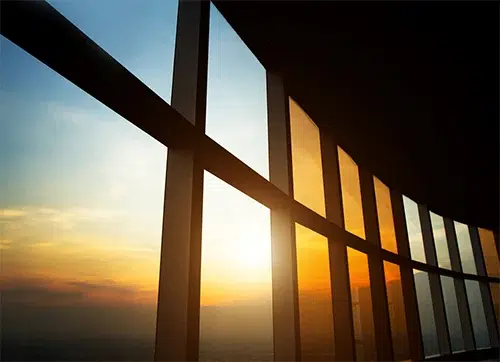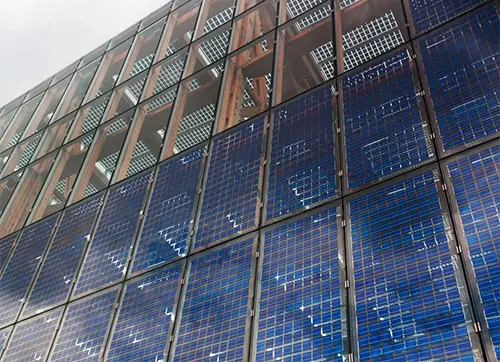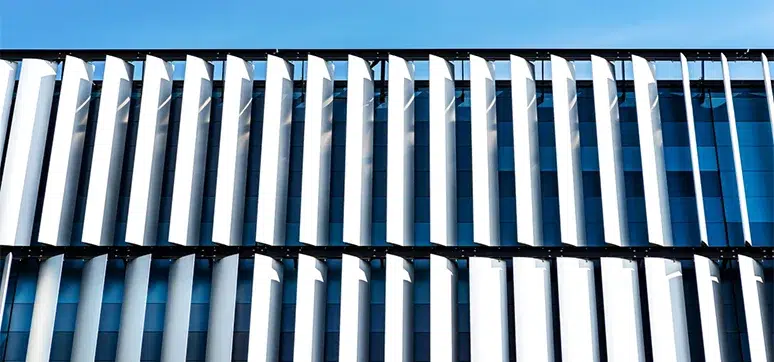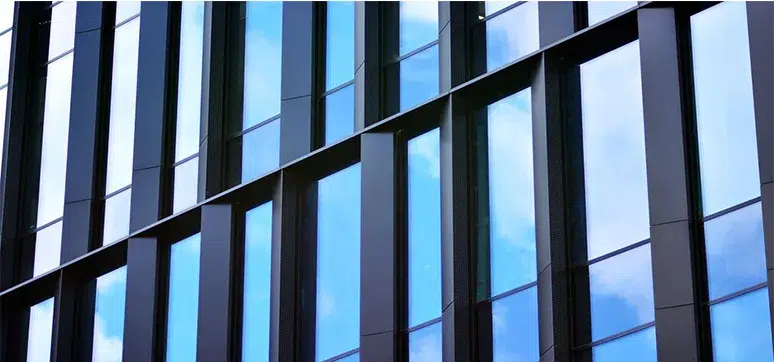As smart building technologies become more prevalent, how do you see façades integrating with these systems to enhance overall building performance?
Integration of façades with smart building technologies has been happening for a while now. The most prevalent example is the integration of shading systems with BMS (Building Management Systems and BAS (Building Automation Systems). This includes internal shading such as blinds and louvers as well as external shading as a part of kinetic façades. Smart glass is also becoming quite popular. Smart glass is one whose VLT (visible light transmittance) changes depending upon external conditions. All of these have served to help façades improve user comfort and energy efficiency of the overall building.
The next step in the process of façade integration with building automation that we can hopefully look forward to is the reduction in risks and costs associated with the same. Improvement in data collection and sensors to allow façades to react quicker and more efficiently to external environmental changes would be a huge benefit to façade automation. Relying on renewable sources of energy such as solar or wind energy could help reduce the overall energy usage of façade automation.
What innovative materials do you anticipate will play a significant role in the development of future façades?
 The building industry constantly sees an influx of new and innovative materials that perform better or provide a better aesthetic. The same is true for façades. Over the past few years fiber reinforced composites have become popular as a building material with the main advantage being high strength-to-weight ratios. FRP (fiber-reinforced plastics) and GFRC (Glass fiber reinforced concrete) are now commonly integrated into façades either as a rain screen panel or as the primary weather barrier itself. UHPC (ultra-high performance concrete) is another such material whose use has been gaining traction over the past few years. Its high tensile strength allows a reduction in material quantities by approximately half compared to traditional precast concrete. With the growing understanding of the importance of materials with low carbon footprints, UHPC offers all the benefits of precast concrete with half the amount of material.
The building industry constantly sees an influx of new and innovative materials that perform better or provide a better aesthetic. The same is true for façades. Over the past few years fiber reinforced composites have become popular as a building material with the main advantage being high strength-to-weight ratios. FRP (fiber-reinforced plastics) and GFRC (Glass fiber reinforced concrete) are now commonly integrated into façades either as a rain screen panel or as the primary weather barrier itself. UHPC (ultra-high performance concrete) is another such material whose use has been gaining traction over the past few years. Its high tensile strength allows a reduction in material quantities by approximately half compared to traditional precast concrete. With the growing understanding of the importance of materials with low carbon footprints, UHPC offers all the benefits of precast concrete with half the amount of material.
While on the topic of low embodied carbon materials, the R&D groups of the façade industry have turned their attention to interesting new types of insulation such as sustainable insulation panels made of mycelium fungi. Aerogel blankets and vacuum insulation panels are now being used to achieve high R-values in limited spaces. Traditional materials like glass are also seeing innovations like VIG (vacuum insulating glass). With the focus turning toward adaptive reuse of existing buildings, these materials with their high R-value per inch, could solve problems of limited space while still achieving high performance.
What are the essential tools used in the creation of future façades?
Design and simulation software have always been at the heart of the façade industry. With the growing importance of high-performance façades some of the new tools that we can look forward to include improved precision in thermal modeling including three-dimensional thermal modeling. Many local codes and certifications now require accurate quantification of thermal bridges to understand and study the energy loss associated with each thermal bridge. Three-dimensional modeling could play a huge role in this.
CFD (computational fluid dynamics) has always been used in the façade industry. More active usage of CFD could help with accurate simulation of exterior wind conditions on façade geometry (especially in projects that do not have a wind tunnel study) as well as study the effect of perimeter diffusers and fin tube radiators on façade performance. However, the biggest asset the façade industry has is designers who understand the need to adapt and design façades sensitive to climate change, carbon footprint reduction, and energy efficiency.
Can you provide insights into the recent advancements in façade and cladding technologies, including materials and construction methods?
 Unitisation of façades has now become commonplace. Unitised façades allow for greater quality control and precision in fabrication. It minimises the risks of onsite installation. Another aspect of the façade design process that greatly improves the performance and quality of façades is Performance Mock-up (PMU) testing. PMU testing involves simulation of worst-case movements, structural loading, air, and water infiltration as well as freeze-thaw cycling of a representative part of a façade. This allows designers and contractors to foresee potential problems in façade design, fabrication, assembly, and trial installation. Construction administration has improved over the past few years. Inspection and commissioning of façades have helped improve the performance and quality of façade systems.
Unitisation of façades has now become commonplace. Unitised façades allow for greater quality control and precision in fabrication. It minimises the risks of onsite installation. Another aspect of the façade design process that greatly improves the performance and quality of façades is Performance Mock-up (PMU) testing. PMU testing involves simulation of worst-case movements, structural loading, air, and water infiltration as well as freeze-thaw cycling of a representative part of a façade. This allows designers and contractors to foresee potential problems in façade design, fabrication, assembly, and trial installation. Construction administration has improved over the past few years. Inspection and commissioning of façades have helped improve the performance and quality of façade systems.
In terms of materiality, one of the biggest advancements is thermally broken façade systems. Thermal breaks in the form of poured-and-abridged polyamide components are now a common part of high-performance curtainwall systems. Rainscreen façade designers now have the option to specify non-metal (e.g. fiberglass) brackets for support of rainscreen panels and insulation. These and many other similar advancements allow for lower U-values of façades.
Could you share your favourite façade material and explain the reasons behind your preference?
My favourite façade material is the timeless classic – Glass. From stained glass windows of Gothic churches to modernism proclaiming glass as a miraculous means of restoring the law of the sun, glass has always been an expressive feature of architecture. The material is extremely versatile in terms of aesthetics. From clear flat plate glass to cold bent glass, textured glass, curved glass, and more – the possibilities are endless. In terms of the performance of glass as a façade material, the advancements are never-ending. Double-insulating glass units (DGUs) have given way to triple-insulating glass units (TGUs) in multiple projects across the world. Vacuum insulating glass (VIG) is now becoming readily available in the market. A wide range of Low-E coatings helps achieve low U-values. The use of interlayers in laminated glass also allows for a new range of aesthetics including lamination of fabric or mesh between two pieces of glass. Laminated glass also offers the benefit of safety glazing and even ballistic glazing.
What features would you like to see incorporated into future façades to enhance their functionality and aesthetics?
For future façades, I’d like to see more incorporation of dynamic shading systems like active louvers or kinetic shading elements which can respond to environmental conditions like sunlight and weather. There have also been research projects that explore “living façades” – façades that can support vertical gardens and improve urban air quality. This would be a wonderful challenge for façade designers to explore.
In terms of functionality, I would like to see the façade industry implementing rules of good practice such as continuous insulation, thermal breaks, continuity of air seal, etc. across the board for all projects, regardless of budget.
How does automation play a role in façades and fenestration, and what are the associated benefits of incorporating automation in building exteriors?
The role of automation in façades and fenestration has increased over the years. Today automation is used in façades to control shading systems such as roller blinds. Automation is also key to the performance of “smart” glass – glass that changes its VLT (visible light transmittance) based on external weather and sunlight conditions. Automated ventilation systems help achieve active ventilation through façades and help improve energy efficiency and user comfort.
What are the key characteristics of a High-performance Façade?
Based on my experience in the façade industry I have learned a few key rules that can make or break a façade. This includes multiple layers of defence – generally in the form of weather and air seals. Continuity of air seal is extremely important to prevent unplanned air and water infiltration. Anticipating paths of potential failure and accommodating the same in a controlled manner makes for a good façade design and this is the basic idea behind a pressure-equalised system.
The cavity between the air and weather seal is pressure equalised to the exterior allowing for water and air to exit this cavity through weeps and vents in the weather seal. Coordination between adjacent trades is often a challenging aspect of construction and design in the façade industry. Paying particular attention to and ensuring robust tie-ins at perimeters can help create a well-performing façade. Continuous insulation and consciously minimising jogs or breaks in the plane of insulation and glazing in the early stages of design is particularly important, especially in colder climates. All façades, whether structural (load-bearing) or non-structural will experience movement – thermal movements, seismic movements, differential movements, etc. Accommodation of movements is crucial in the design of façades.
In the context of climate change, how can façades be designed to withstand extreme weather conditions while maintaining their aesthetic appeal?
Façades are the skin of buildings. They are first the layer of defense against external weather conditions. This also makes them the most vulnerable to energy loss to the exterior. In the context of climate change, it is now more important than ever for façades to be adaptable and capable of withstanding extremes of temperature, wind, and other weather phenomena. As façade designers, we can explore ways to incorporate passive and energy-efficient means of cooling and shading of façades. Façades should also be designed with thermal efficiency in mind. Building codes are now becoming more stringent and the prescriptive U-values are becoming lower with each new edition. 50 and 100-year storm events are now becoming frequent, requiring façades to be designed to withstand higher structural loads. Architects across the world also understand the importance of reducing in carbon footprint of the construction industry. As façade designers, we must evaluate every material choice and design decision to weigh its global warming potential.
As urban spaces become more interconnected, how might façades contribute to creating a sense of community and connectivity within and between buildings?
Façades play a major role in the rich urban fabric of cities across the world. Façades often incorporate multiple scales. For example, a unitised curtainwall on a tower flows into the human scale at the street level in the form of storefronts nestled under canopies. This helps create a different sense of community from the street to the skyline of a city. Differing levels of transparency of façades is an important feature of cities – this helps transition from an inward focus within the building to an outward focus on the neighborhood around. Well-designed façades offer a clever distinction between the indoors and outdoors and can blend seamlessly from one to the other. Concepts like Privately owned public spaces (POPS) have successfully been explored in multiple cities across the world. Façades play a major role in POPS – storefronts opening into arcades, atriums carved into lobbies, and canopies swooping over a semi-outdoor seating area. Façades also offer a canvas for digital displays of art, advertisements, and public information in cities.
How do you envision the future of façade design, considering the evolving technologies and materials in the field?
The future of façade design will have a greater emphasis on sustainability – greater energy efficiency, lower embodied and operational carbon as well as higher resiliency. High performance has already started to become the norm of the façade industry and hopefully, façades will continue to evolve in this aspect. We will see the advent of new and innovative material in the future. Above all, hopefully, the future of façades holds inspiring and thoughtful designs that will leave us all in awe.















